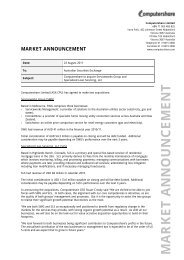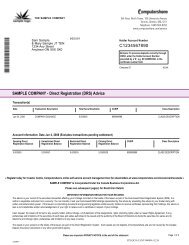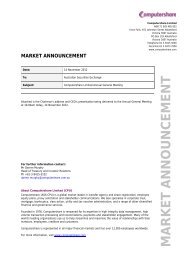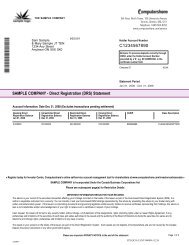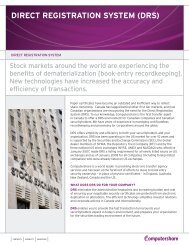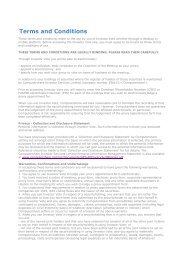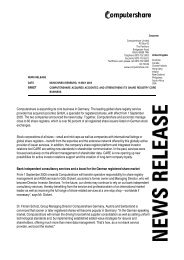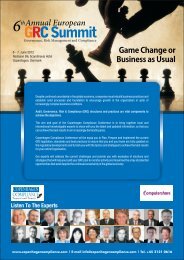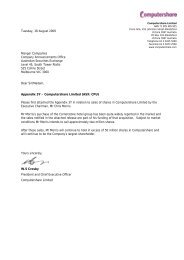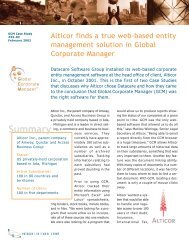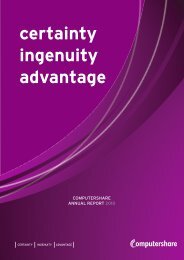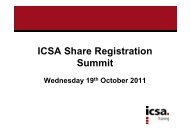COMPUTERSHARE ANNUAL REPORT 2008
COMPUTERSHARE ANNUAL REPORT 2008
COMPUTERSHARE ANNUAL REPORT 2008
You also want an ePaper? Increase the reach of your titles
YUMPU automatically turns print PDFs into web optimized ePapers that Google loves.
Notes to the Financial StatementsTransactions and balancesForeign currency transactions are converted to US dollars at exchange rates approximating those in effect at the date of eachtransaction. Amounts payable and receivable in foreign currencies at balance date are converted to US dollars at the average ofthe buy and sell rates available on the close of business at balance date. Revaluation gains and losses are brought to account asthey occur.Exchange differences relating to monetary items are included in the income statement, as exchange gains or losses, in theperiod when the exchange rates change, except when deferred in equity as qualifying cash flow hedges and qualifying netinvestment hedges.Group companiesAll resulting exchange differences from the translation of the results and financial position of all the Group entities that havea functional currency other than US dollars are recognised as a separate component of equity. On consolidation, exchangedifferences arising from the translation of any net investment in foreign entities, and of borrowings and other currency instrumentsdesignated as hedges of such investments, are taken to shareholders’ equity.Goodwill and fair value adjustments arising on the acquisition of a foreign entity are treated as assets and liabilities of the foreignentity and translated at the closing rate.Income taxThe financial statements apply the principles of tax-effect accounting. The income tax expense in the income statement representstax on the pre-tax accounting profit adjusted for income and expenses never to be assessed or allowed for taxation purposes. This isalso adjusted for changes in deferred tax assets and liabilities attributable to temporary differences between the tax bases of assetsand liabilities and their carrying amounts in the financial statements.Deferred tax assets and liabilities are recognised for temporary differences calculated at the tax rates expected to apply when thedifferences reverse. Deferred tax assets are recognised for deductible temporary differences and unused tax losses only if it isprobable that future taxable amounts will be available to utilise those temporary differences and losses. Deferred tax assets andliabilities are offset when there is a legally enforceable right to offset current tax assets and liabilities and when the deferred taxbalances relate to the same taxation authority.Deferred tax assets and liabilities are not recognised for temporary differences between the carrying amount and tax bases ofinvestments in subsidiaries where the parent entity is able to control the timing of the reversal of the temporary differences and it isprobable that the differences will not reverse in the foreseeable future.Current and deferred tax balances attributable to amounts recognised directly in equity are also recognised directly in equity.Tax consolidation legislationComputershare Limited and its wholly-owned Australian entities implemented the tax consolidation regime with effect from1 July 2002. The Australian Taxation Office has been formally notified of this decision.The relevant entities have also entered into a tax sharing deed, which includes tax funding arrangements. As a consequence,Computershare Limited, as the head entity in the tax consolidation Group, has recognised the current tax liability relating totransactions, events and balances of the wholly owned Australian subsidiaries in this Group in the financial statements as if thatliability was its own, in addition to recognising the current tax liability arising in relation to its own transactions, events and balances.Amounts receivable or payable under the tax sharing deed are recognised separately as tax related intercompany payables orreceivables. The parent entity and the other relevant entities continue to account for their own deferred tax amounts.LeasesLeases of property, plant and equipment where the Group has substantially all the risks and rewards of ownership are classifiedas finance leases. Assets acquired under finance leases are capitalised and amortised over the life of the relevant lease, or whereownership is likely to be obtained on expiration of the lease, over the life of the asset. Lease payments are allocated betweeninterest expense and reduction in the lease liability.Leases in which a significant portion of the risks and rewards of ownership are retained by the lessor are classified as operatingleases. Operating lease assets are not capitalised and rental payments (net of any incentives received from the lessor) are chargedagainst operating profit on a straight line basis over the period of the lease.Leasehold improvementsThe cost of improvements to or on leasehold properties is amortised over the unexpired period of the lease or the estimated usefullife of the improvement to the consolidated entity, whichever is the shorter.Software and research and development costsInternally developed software and related research and development costs are expensed in the year in which they are incurred asthey do not meet the recognition criteria for capitalisation.PAGE 42 Computershare Annual Report <strong>2008</strong>



